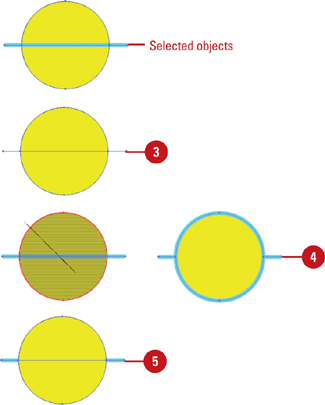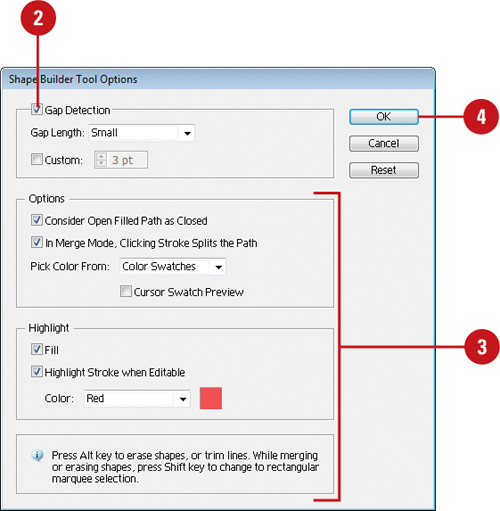The Shape Builder tool (New!)
allows you to create complex objects by merging and erasing simpler
objects. The Shape Builder tool selects edges and regions of an object,
which can be merged or erased to form a new object. An edge is any
section of a path that doesn’t intersect the path of other selected
objects and a region is a closed area. You can also break overlapping
objects to create new ones. The style attributes of an object are
adopted after the merge. By default, the Shape Builder tool is in merge
mode, however, you can switch to erase mode by using the Option (Mac) or
Alt (Win) key. Before you start using the Shape Builder tool, you can
set up and customize options, such as coloring source, highlighting, and
gap detection, to suit your own preferences.
Create an Object with the Shape Builder Tool
- 1. Click the Selection tool on the Tools panel, and then select only the paths you want to merge to create a shape.
- 2. Click the Shape Builder tool on the Tools panel. By default, merge mode is selected.

- 3. To break or extract a region from the shape, click the selected region.
- 4. To merge paths, drag along the region.
The two regions get merged to form a new shape. The attributes from the region are applied to the merging shapes.
Timesaver
Press Shift as you drag, displays a rectangle marquee for merging multiple paths.
- 5. To erase paths, press Option (Mac) or Alt (Win) and click the closed region or edge you want to delete.

Set Shape Builder Tool Options
- 1. Double-click the Shape Builder tool on the Tools panel.

- 2. To detect and show the gap between objects, select the Gap Detection check box, and then select a Gap Length, either Small (3 points), Medium (6 points), or Large (12 points), or select the Custom check box and specify a point size length.
Important
Make sure the gap length value is close to the actual gap length, otherwise Illustrator may not detect it.
- 3. Specify the Options and Highlight settings you want:
- Consider Open Filled Path as Closed. Select to create an invisible edge for an open path to make a region.
- In Merge Mode. Clicking Stroke Splits the Path. Select to split the parent path into two; the first edge you click specifies the split location.
- Pick Color From. Select Color Swatches or Artwork as the source for coloring objects. If you select Color Swatches, select the Cursor Swatch Preview check box to preview and select colors.
- Fill. Select to highlight the merged area in gray or mouse over the selected path.
- Highlight Stroke When Editable. Select to highlight strokes you can edit in the color you select.
- 4. Click OK.

|